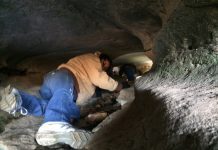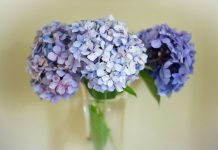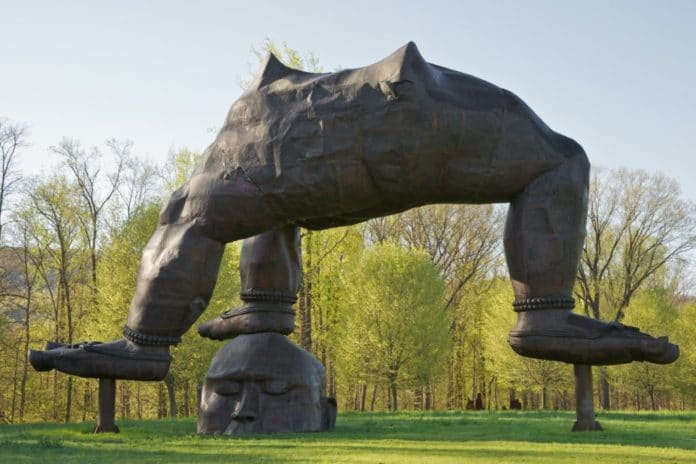Once upon a time not so very long ago, my husband David and I had an artful, giant-filled adventure when we visited Storm King Art Center, an expansive, 500 acre outdoor museum and sculpture park nestled on gently curated hilltops and in miniature patchwork meadows in New York’s idyllic Hudson Valley.
Since 1960 Storm King has been dedicated to stewarding the highlands, lowlands and forests of the center’s site and surrounding landscape. The first acquired sculptures were placed in a formal garden outside the Museum Building, originally a large, stone and slate-roofed residence built in 1935 as though modeled on a storybook illustration.
Storm King supports renowned giants of the art world—modern and contemporary artists and some of their most ambitious outdoor works. Each work is carefully sited as part of a vast visual fabric. More information on the collection can be found at collections.stormking.org.
Our spring day visit was fair with hints of blue heavens shining from behind dramatically jostling rain-laden clouds. Our hearts were happy. Our eyes eager for discovery.
Journeying north from Ridgewood, New Jersey, our east-coast-traffic-experienced driver speeded over the Palisades Interstate Parkway then slowed to wind on old two lane roadways threading through villages made quaint with Victorian cottages and stacked stone walls and brooks that seemed to be singing.
Our in-search-of-art-and-giants companions were our two granddaughters—Sophie, almost six-years-old, and Xandie, just six-months—and their adventuresome, art-loving mom, Audrey. We arrived early morning well-equipped with extra wraps and an all-terrain stroller for the baby. Yes, our family believes no one’s ever too young or too old to engage in artful adventuring and giant stalking. To find terrific art and giants outdoors is awesome!
Storm King Art Center’s new season was just opening. The old growth trees were just beginning to leaf out, so the vistas were wide and stretched far across the manicured park to the distant mountains. Young trees thoughtfully arranged—a copse here, a bosky there—offered bouquets of soft spring-green textures contrasting with the massive, heavy art works constructed of media chosen to endure outdoor elements.
Each in our art-seeking, traveling party had a special role to play. Mine was as family photographer and documentarian; Audrey, our capable driver and guide to our artful destination, multi-tasked mommie duties while keeping us loosely organized and pointed toward must-see installations; Baby Xandie simply smiled, napped, cooed and was our all-day darling; Sophie, who always runs or skips and never walks, kept us briskly, exuberantly moving; and David provided tons of Grandpère fun while serving as Sophie’s personal Sherpa as he uphill-pushed the baby’s stroller on steep inclines.
Storm King is about the serious business of preserving art for future generations to come. There are even cautions posted in the lavatories explaining the “no touch” policy, because natural oils, dirt, sunscreen, bug spray, hand sanitizer or lotion on our hands can irreparably damage the surface of sculptures. Visitors are encouraged to look but not to touch or climb. As exceptions, there are select works designated for interaction.
The interactive “Momo Taro” by Isamu Noguchi is the first sculpture to which Sophie ran for her initial photo op. Noguchi visited Storm King in 1977, surveyed the landscape, selected a site, then returned to his studio on the Japanese island of Shikoku to work on “Momo Taro”. One of his assistants searched for boulders on the nearby island of Shodoshima, in the Seto Inland Sea, and found one too large to move; the boulder had to be split. The rock’s appearance after being split reminded his assistants of “Momo Taro”, an ancient folk hero who emerged from a peach pit to become the son of an elderly couple. The work was finished within a year and was installed in the spring of 1978. Today visitors are invited to enter, to sit and to unite their bodies with the work—to participate in its existence. Noguchi wished for children to climb in and sing inside the cavity. The “center” of the piece—the hollowed out “peach pit”—serves as a peaceful retreat. Even on the hottest summer days this interior remains cool.
Another family favorite was Alyson Shotz’s “Mirror Fence”—a simple picket fence that magically reflects the minutia of the landscape.
When from the top of a lawn sidekicks Sophie and David saw a sculpture below that appeared too far and slow to reach by following the long paved path, simultaneously they stretched out on the grass and began to roll down-down-down the slope, their arms and legs and laughter flying all around them as they came to rest at the feet of our favorite giant in all of Storm King—the huge “Three Legged Buddha” (2007) by Zhang Huan!
Yes, once upon a time not so long ago we visited Storm King Art Center with three most delightful companions. We’ve brought home many happy memories and pictures of art and giants—enough to fill a storybook! We should write one!

















